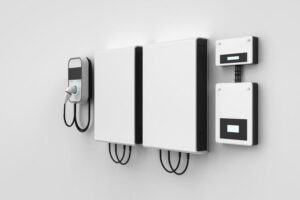In the field of new energy, the wind-solar hybrid system is highly favored for its high efficiency and stability. As the “brain” of the system, the selection, connection and debugging of the controller are crucial. This article will explore all aspects of the wind-solar hybrid controller in depth, providing you with comprehensive and professional guidance.
1. Photovoltaic controller: the commander of the wind-solar hybrid system
Basic concept: What is a photovoltaic controller?
The photovoltaic controller is an indispensable core component in the wind-solar hybrid system, which is mainly responsible for regulating and controlling the charging and discharging process between the solar panel and the battery. It is like the “commander” of the system, ensuring that the entire system operates efficiently, safely and stably.
Working principle: How does the photovoltaic controller work?
The working principle of the photovoltaic controller is mainly based on the following aspects:
1. Charging control: According to the state of the battery, the controller will automatically adjust the charging current and voltage to prevent overcharging.
2. Discharge protection: When the battery power is too low, the controller will cut off the load to prevent over-discharge.
3. Maximum power point tracking (MPPT): High-end controllers have MPPT function, which can adjust the working point in real time so that the solar panel always works at the optimal power point.
4.Data monitoring: Real-time monitoring of system operation data, such as voltage, current, power, etc., so that users can understand the system status.
Control principle: In-depth understanding of the “brain” of the photovoltaic controller
The control principle of the photovoltaic controller mainly includes:
a) PWM (pulse width modulation) control: Control the charging process by adjusting the width of the charging pulse, which is suitable for small systems.
b) MPPT control: By continuously adjusting the working point, the solar panel outputs maximum power, which is more efficient and suitable for large systems.
c) Three-stage charging: Including constant current charging, constant voltage charging and floating charging, which can extend the life of the battery.
d) Temperature compensation: Automatically adjust the charging parameters according to the ambient temperature to ensure charging efficiency and battery life.

2. Wind-solar hybrid controller system: A perfect partner for coordinating wind energy and solar energy
The wind-solar hybrid controller system is mainly composed of the following parts:
a) Solar panels: Convert solar energy into electrical energy.
b) Wind turbines: Convert wind energy into electrical energy.
c) Controller: Coordinate and manage the operation of the entire system.
d) Battery pack: stores excess power for use when there is no wind or sun.
e) Inverter: converts DC power into AC power for use by household appliances.
f) Monitoring system: monitors the system operating status in real time.
Operation mode: the “working state” of the wind-solar hybrid system
The wind-solar hybrid system mainly has the following operation modes:
a) Photovoltaic power generation mode: when there is sufficient sunlight, it mainly relies on solar power for power generation.
b) Wind power generation mode: when there is sufficient wind power, it mainly relies on wind power for power generation.
c) Complementary power generation mode: wind and solar power are powered at the same time to maximize efficiency.
d) Battery power supply mode: when there is no wind or sun, it is powered by batteries.
e) Mains power supplement mode: in some grid-connected systems, when wind and solar power are insufficient, they can be supplemented by mains power.
3. Selection of photovoltaic controller: choosing the best “brain” for the wind-solar hybrid system
Choosing a suitable photovoltaic controller is crucial to the performance of the wind-solar hybrid system. The following are the key factors to consider when selecting:
System voltage
First, determine the operating voltage of the system, which is commonly 12V, 24V, 48V, etc. The rated voltage of the controller must match the system voltage.
Charge and discharge current
The rated charge and discharge current of the controller should be greater than the maximum charge and discharge current of the system. It is usually recommended to reserve a margin of 20%-30% to ensure safety and scalability.
Control method
Choose PWM or MPPT control method according to the system scale and efficiency requirements. For large systems or scenarios requiring high efficiency, it is recommended to choose an MPPT controller.
Functional characteristics
Consider additional functions of the controller, such as temperature compensation, data logging, remote monitoring, etc. These functions can improve the reliability and manageability of the system.
Brand and quality
Choose products from well-known brands to ensure quality and after-sales service. You can check product certifications, such as CE, RoHS, etc., to ensure that the product meets relevant standards.
Price and cost-effectiveness
On the premise of meeting technical requirements, comprehensively consider price factors and choose the product with the highest cost-effectiveness.
Adaptability
Consider the adaptability of the controller to the working environment, such as temperature range, waterproof level, etc., to ensure that it can work stably in the actual application environment.
IV. Connection and debugging of wind-solar hybrid controller: Correct installation of the “brain” of the system
Correct connection and debugging are the key to ensuring the efficient operation of the wind-solar hybrid system. The following is a detailed step-by-step guide:
Safety preparation checklist:
- Wear appropriate protective equipment.
- Prepare required tools.
- Read controller manual.
- Select suitable installation location: ventilated, dry, and away from direct sunlight and rain.
- Ensure ample space for heat dissipation.
- Follow correct wiring sequence: battery, solar panel, wind turbine, load.
- Use proper cable specifications for battery connection.
- Secure battery connection and install a fuse at the positive pole.
- Check solar panel voltage compatibility and configure series-parallel configuration if necessary.
- Install anti-reverse diodes for panel protection.
- Match wind turbine output voltage to the controller and install a three-phase rectifier bridge (if needed).
- Install a lightning protection device.
- Ensure load power is within controller limits; consider relay control for high-power loads.
- Set controller parameters: system voltage, battery type, charge/discharge settings, load control mode.
- Conduct system debugging, checking connections, indicator lights, charging, and discharging functions.
- Verify proper functioning of protection features.
- Monitor and record system data, analyze for optimization.
- Configure remote monitoring (if applicable) and test functionality.
- Develop a regular maintenance plan: clean panels/turbines, check wiring, update firmware, monitor battery status.
V. Optimization and improvement of wind-solar hybrid system
In order to further improve the efficiency and reliability of wind-solar hybrid system, the following optimization measures can be considered:
Intelligent load management
Implement intelligent load management strategy to automatically adjust the working status of power equipment according to power generation and power demand to maximize the use of renewable energy.
Energy storage technology upgrade
Consider using advanced energy storage technologies, such as lithium batteries or flow batteries, to improve the energy storage capacity and efficiency of the system.
Predictive maintenance
Use artificial intelligence and big data technology to achieve predictive maintenance of the system, detect potential problems in advance, and reduce unexpected downtime.
Multi-energy complementarity
On the basis of wind and solar energy, consider introducing other renewable energy sources, such as biomass energy, geothermal energy, etc., to further improve the stability and reliability of the system.
Microgrid technology
Combining wind-solar complementary systems with microgrid technology to achieve more flexible and efficient energy management and distribution.
Carbon trading participation
For large-scale wind-solar complementary systems, you can consider participating in the carbon trading market to obtain additional benefits through emission reduction.
Conclusion: Future prospects of wind-solar complementary systems
As an important way to utilize clean energy, wind-solar complementary systems play an increasingly important role in the global energy transformation. With the continuous advancement of technology, the performance of wind-solar complementary controllers will be further improved, and the efficiency and reliability of the system will continue to improve.
learn more :wind-solar hybrid system




